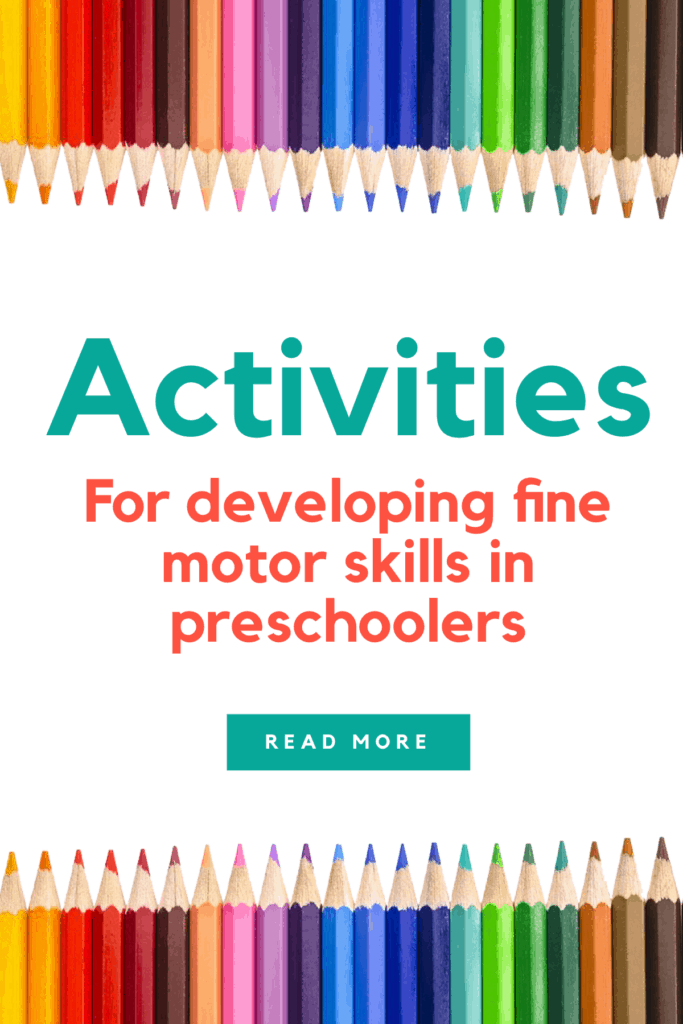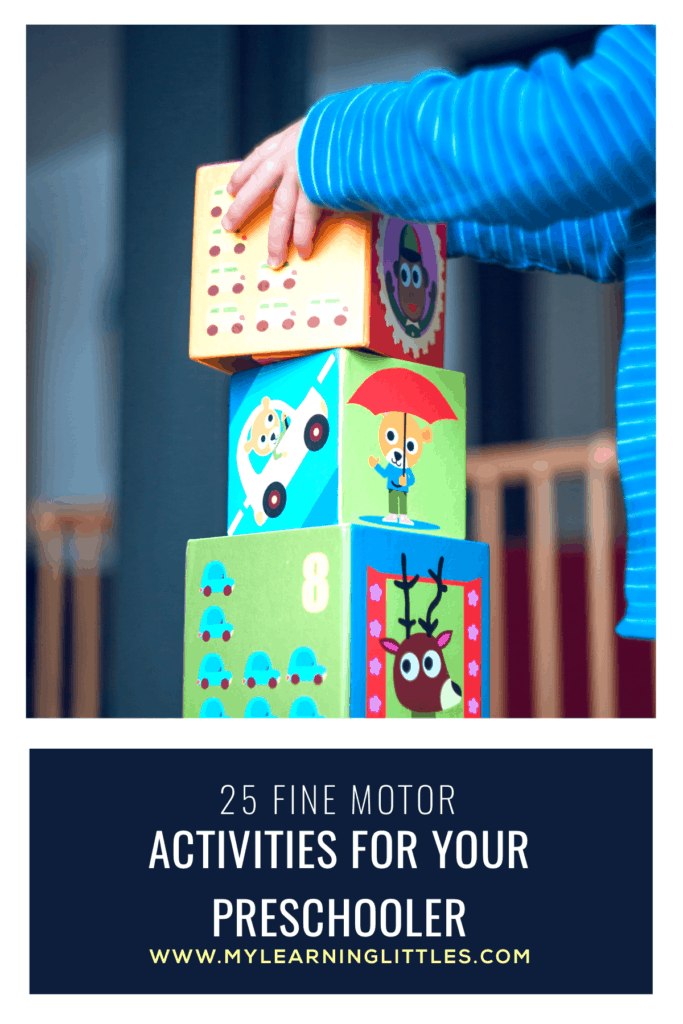Fine Motor skills…. Aka skills to do all the little things. They may seem second nature to an adult, but children are developing them as they learn.
Lots of activities are great for mastering fine motor skills. Out of the 25 activities below we especially like: cutting practice, manipulating clothes pins, playing with sponges in water and single hole punches.
Fine motor practice can be fun and may require a little patience. We love to work on fine motor skills daily to help our little ones develop their muscles.
Fine Motor Skills
We work on our fine motor skills when we do things with our hands. Babies start using their hands early… sometimes in the womb. We had a few ultrasounds with a little thumb sucker. I love watching a baby explore with their hands, especially when they are cautious or clumsy. Watching the awe they have for new objects puts a huge smile on my face. Fine motor skills develop once gross motor becomes a little more stable. Once toddlers can control their bodies, limbs and heads more. As children learn with their hands they are also developing cognitive, social and emotional skills.
In preschool children learn to tie their shoes, dress themselves, sometimes with buttons or snaps, hold a pencil or paint brush, play with blocks or cars and dress dolls. These are all good examples of fine motor skills at work. Keep in mind working on fine motor skills means their little muscles are developing as well. Often times fine motor tasks are more delicate and complicated and become will be tiring or more difficult than gross motor tasks. Typically preschoolers are full of energy, but these activities require patience which is a little more challenging to develop.

Fine Motor Milestones
Two year olds: Can build a tower of up to eight blocks. Typically holds pencil between fingers instead of grasping with fist.
Three year olds: Can build a tower of nine or ten blocks. Can puts on shoes and socks by themselves or with little guidance. Can button and unbutton buttons on shirt or pants. Can carry a container with little spilling or dropping.
Four year olds: Can dress self, except for tying laces or drawstrings. Can cut with scissors independently, but may not be perfect. Can wash and dry face and hands.
Read more: http://www.healthofchildren.com/E-F/Fine-Motor-Skills.html#ixzz6Ls2itMB8
Fine Motor Activities
Here are some activities that you can do with your child to help them develop thier muscles in thier hands and progress thier fine motor skills.
- Color a coffee filter with markers and use a spray bottle filled with water and watch the colors blend and melt. Working the spray bottle will work those hand muscles.
- Hide small objects like coins or beads inside kinetic sand and have your child dig through with their fingers to find the objects. Like a treasure hunt on the table.
- Give your child a ball of Play Dough and have them practice pinching the dough. Or roll out a line of Play Dough and have them make pinch like designs in the dough.
- Use clothespins and have your child place the clothes pins on paper cardstock. You can label the clothes pins with letters or numbers and have them put them in order. Or write a capital letter on a paper and lower case letter on the clothes pin and have them match them.
- Cut out shapes from card stock and have your child use clothes pins to hang the shapes on a wire or string.
- Get out two cereal bowls. Fill one bowl with water and leave the other empty. Have your child soak a sponge in the water and then squeeze out the sponge into the other bowl. It’s a simple game that can strengthen hands and forearms and they will love splashing in the water.
- Lace Cheerios, Fruit Loops, or other round cereal on string or yarn and make necklaces or bracelets. They can eat the cereal afterward and have a fun way to eat a snack.
- Lace dry pasta like macaroni, rigatoni or penne noodles on yarn or string. You can dye the pasta different colors easily to make patterns. Put some of the dry noodles in a large, ziplock bag with a few drops of rubbing alcohol and some food coloring, shake until it’s distributed and place the noodles on a layer of paper towels to dry overnight.
- Save small tops and spinners from birthday party goodie bags to develop fine motor skills in those little fingers. Spinning a top uses the same fine motor skills needed to snap fingers.
- Spread cards, coins, or buttons on the floor and encourage your preschooler to flip them over. We like to play memory with a deck of cards and different surfaces make play more challenging. Picking up cards from the carpet or couch is easier than the dining room table or tile floor.
- Use a manual eggbeater in a bowl of water. Add dish soap for some extra bubble fun. Your little one will love the handmade bubbles.
- At a craft store pick up small paper punches and have your child use them to punch out different shapes with construction paper or card stock.
- Vary types of materials your child cuts with safety scissors. Newspaper, printer paper, card stock, old greeting cards. The variety of materials will give them great practice. It doesn’t matter too much how the finished result looks. Work on holding the scissors correctly and moving the paper with the opposite hand.
- Take some of the papers you cut or punched out and paste them onto paper. Applying glue to the small papers, flipping them over and pasting them to the bigger paper will use all their hand muscles and require patience to place them in the desired spot.
- Have your child start using a fork or spoon at meals. Resist the urge to help, let them figure it out on their own. My son loves to eat cereal with milk. He started at 20 months and made quite a mess dripping milk and food all over himself. But with time he has learned to keep the spoon more horizontal and stays dry.
- Provide small pieces of chalk or broken crayons for children to write or draw with. Because the writing utensils are broken it will require more patience to hold and use effectively.
- Pour clear hair gel and a few drops of food coloring in a sandwich bag. Mix them together and force all the air out of the bag and seal tightly with packing tape or duct tape. Place the bag on a flat surface and encourage children to use their index fingers to practice letters or numbers on the bag. The texture will be fun!
- Use a clothes pin to transfer beads or coins from one container to another. This activity will strengthen the pincher grip required for writing.
- Take newspaper and have your child hold it at the top with two hands. Have them tear the paper apart into two pieces. Have your child crumple up half of the paper with one hand. Then crumple up the other half with the other hand. Crumpling will work their hands and forearms.
- Make cutting mazes or patterns on card stock or construction paper. Have them follow the lines with safety scissors and cut their way through the maze. You can also have your child draw their own maze and then practice cutting it.
- Q-tip painting is a fun activity for to work on details. Write your child’s name on paper and have them dot the line with paint. Vary their strokes by doing dots, making lines or swirls as well.
- Write letters or make circles on a sheet of paper and have your child use a single hole punch to practice punching out the circles or letters. I like to use this activity every few days with my son. The single hole punch requires strength and he gets tired easily.
- Tape a large piece of paper to an easel or the wall and have your child practice drawing a line from the top to the bottom of the paper.
- On a large piece of paper, draw a simple shape or line. Take turns connecting a different shape or line to create a new object. You can continue doing this until the paper is full or your masterpiece is complete. Be creative and use curvy lines and a variety of different shapes, encouraging your child to do the same.work a zipper
- Do puzzles with five or more pieces. Local dollar stores often have lots of fun puzzles with a variety of piece counts.

There are lots of activities that can help your preschooler develop their fine motor skills. These ideas are just a few ways to help them. Please share with us in the comments if you enjoy any of these activities with your child.